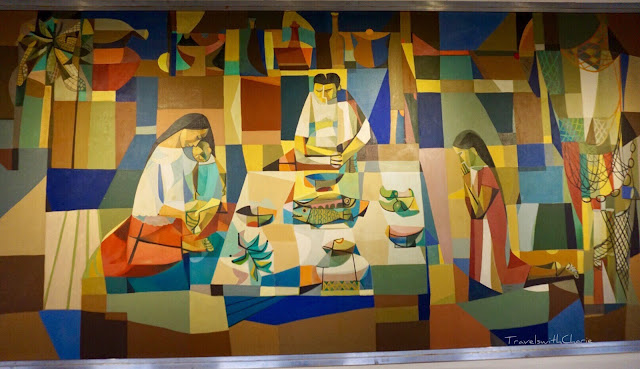"If art is to nourish the roots of our culture, society must set the artist free to follow his vision wherever it takes him." John F. Kennedy
 |
| Spoliarium by Juan Luna |
 |
| The Assassination of Governor Bustamente by F. Hidalgo |
Felix Resurección Hidalgo studied at the Real Academia de Bellas Artes de San Fernando de Madrid as a pensionado of the Ayuntamiento de Manila. He won the ninth silver medal in 1884 for his work, Las Virgines Cristianas Expuestas al Populacho at the Exposicion General de Bellas Artes in Madrid at which event, Juan Luna won the gold medal for his Spoliarium. The Assassination of Governor General Fernando Bustamante y Rueda is a controversial painting for its depiction of the Dominican friars as active participants in the murder of the Governor. In fact, Fr. Fidel Villaroel, Ph.D., a Spanish historian and Filipinologist from the University of Santo Tomas contends that the friars were imprisoned together with the bishop at the time of the murder.
 |
| The Struggles of the Filipino People by Carlos 'Botong' Francisco |
The Struggles of the Filipino People is a series of paintings by 1973 National Artist, Carlos Botong Francisco commissioned by former Manila Mayor, Antonio Villegas, for the Manila City Hall. The image above is a bird's eye view of the paintings on display at the former Senate Session Hall.
In the painting above, a Datu/Sultan and his princess examine the trade goods presented by a Chinese merchant while a Muslim preacher in the background introduces Islam to the people around him. (pre-colonial Philippines) Check this link for more information about The Struggles of the Filipino People:
Pamilya is part of a series of large scale paintings by 1981 National Artist, Vicente Manansala. It is on loan from PhilAm Life. To see and learn more about the entire PhilAm Life series of paintings by Manansala, click this link:
 |
| The Struggles of the Filipino People |
 |
| Pamilya |
https://www.travelswithcharie.com/2020/08/the-philippine-village-life-by-vicente.html
 |
| Sulayman and His Court |
Rajah Sulayman and His Court is a wood relief by Napoleon V. Abueva, a 1976 National Artist for Sculpture with the assistance of Renato Rocha and Jose Mendoza.
Show Window is a non woven tapestry (Art Protis) by Federico Aguilar Alcuaz, a 2009 National Artist for Visual Arts. This tapestry is from the GSIS collection.
 |
| Show Window by Federico Aguilar Alcuaz |
The fine art collection of the National Museum also includes the works of Fernando Amorsolo, a beloved Filipino painter known for his colorful scenes of the Philippine countryside and the idyllic life.
I was amazed by the breadth of the art collection at the National Museum. There's so much to see and learn about Philippine art and heritage that a day at this museum isn't quite enough to take it all in.
About the National Museum:
P. Burgos Drive, Rizal Park, Manila
nationalmuseum.gov.ph
Entrance is free. Drop off handbags, backpacks and any hand carried items at the coat check counter in the front lobby. Photos with no flash may be taken.
Stay connected

*****
Images by TravelswithCharie
I was amazed by the breadth of the art collection at the National Museum. There's so much to see and learn about Philippine art and heritage that a day at this museum isn't quite enough to take it all in.
About the National Museum:
P. Burgos Drive, Rizal Park, Manila
nationalmuseum.gov.ph
Entrance is free. Drop off handbags, backpacks and any hand carried items at the coat check counter in the front lobby. Photos with no flash may be taken.
Stay connected
*****
Images by TravelswithCharie